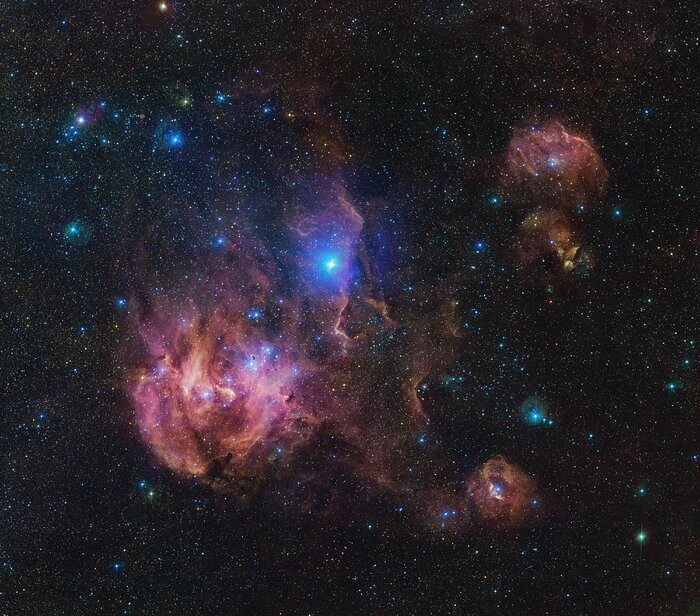Amidst holiday traditions featuring diverse feasts, the European Southern Observatory (ESO) presents a unique celestial treat-the Running Chicken Nebula.
This spectacular stellar nursery captured in a 1.5-billion-pixel image by the VLT Survey Telescope in Chile is situated in the Centaurus constellation about 6,500 light-years from Earth, showcasing young stars emitting intense radiation, illuminating surrounding hydrogen gas in vibrant pink hues.

The Running Chicken Nebula captured by the VLT Survey Telescope (VST).
Running Chicken Nebula: A Celestial Tapestry of Young Stars and Ethereal Plumes
The Running Chicken Nebula, an expansive celestial spectacle, unveils diverse regions across its expansive image, covering an area equivalent to approximately 25 full Moons. A focal point within this cosmic entity is IC 2948, where observers discern varied shapes, resembling anything from a chicken's head to its rear end.
The nebula's delicate contours depict otherworldly plumes of gas and dust, with the central region highlighted by a luminous, vertical structure identified as IC 2944, featuring the visible star Lambda Centauri, which is closer to Earth than the nebula itself.
IC 2948 and IC 2944 host a plethora of young stars, emitting significant radiation that dramatically shapes their surroundings, reminiscent of a chicken carving through its environment. Remarkably, specific nebula areas, known as Bok globules, withstand the relentless barrage of ultraviolet radiation.
Termed the Running Chicken Nebula and the Lambda Centauri Nebula, IC 2944/2948 functions as an emission nebula harboring the recently formed Collinder 249 open star cluster, originating from a cloud 7.9 million years ago. Situated in the Centaurus constellation, approximately 5,800 to 6,500 light-years away, it encompasses the bright star Lambda Centauri, humorously nicknamed due to the bird-like shape of its brightest region, despite its closer proximity to Earth and its independent nature from the nebula.
READ ALSO: Now You See Me, Now You Don't: Massive Telescope Captures Mystery Cosmic Disappearance
ESO's Image Reveals Vast Mosaic of Celestial Fireworks
Aside from showcasing the nebula, ESO's new image also captures a celestial display resembling fireworks with numerous colorful stars. It is a vast mosaic, a result of combining hundreds of frames taken through various color filters, as part of the VST Photometric Hα Survey of the Southern Galactic Plane and Bulge (VPHAS+). The project aims to unravel the life cycle of stars, offering a rich tapestry of details for exploration.
Upon closer inspection, small, dark, and dense pockets of dust and gas emerge, scattered across the nebula. Additional regions, such as Gum 39 and 40 to the upper right and Gum 41 to the lower right, contribute to the overall spectacle. The image is a visual feast, featuring countless orange, white, and blue stars that resemble a vibrant display of fireworks against the cosmic backdrop.
This intricate image is a meticulously crafted mosaic, seamlessly stitching together hundreds of individual frames captured through filters allowing different colors of light. The observations were conducted using OmegaCAM on the VST, a telescope owned by the National Institute for Astrophysics in Italy (INAF) and hosted by ESO at its Paranal site in Chile's Atacama Desert.
As an intergovernmental organization established in 1962, ESO collaborates internationally to explore the mysteries of the Universe, designing, building, and operating cutting-edge observatories like the Very Large Telescope and ALMA in the Atacama Desert.
RELATED ARTICLE: Exquisite Image of Spiral Galaxy Coma Pinwheel Sighted by ESO's Very Large Telescope [Look]
Check out more news and information on Space in Science Times.














